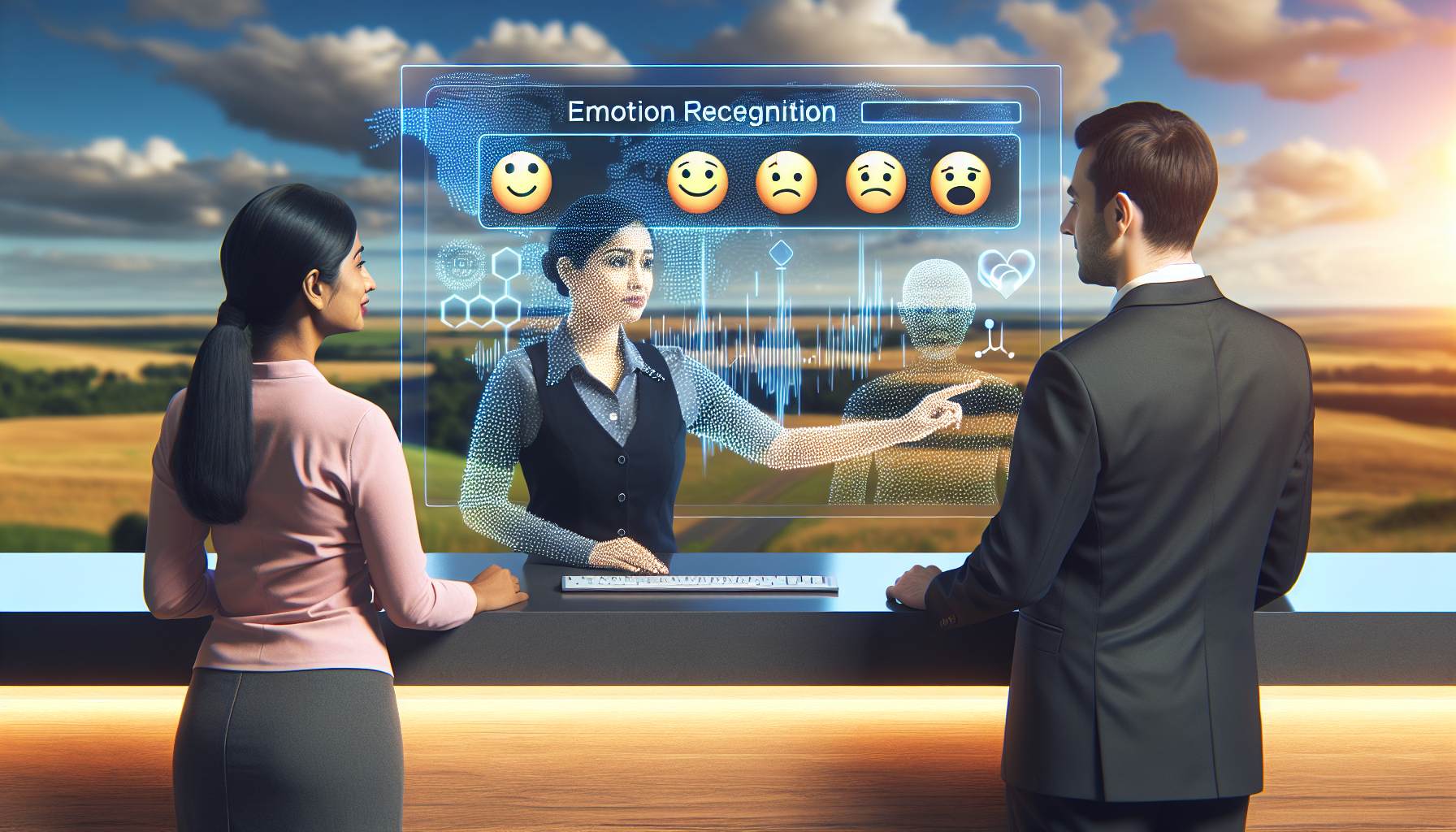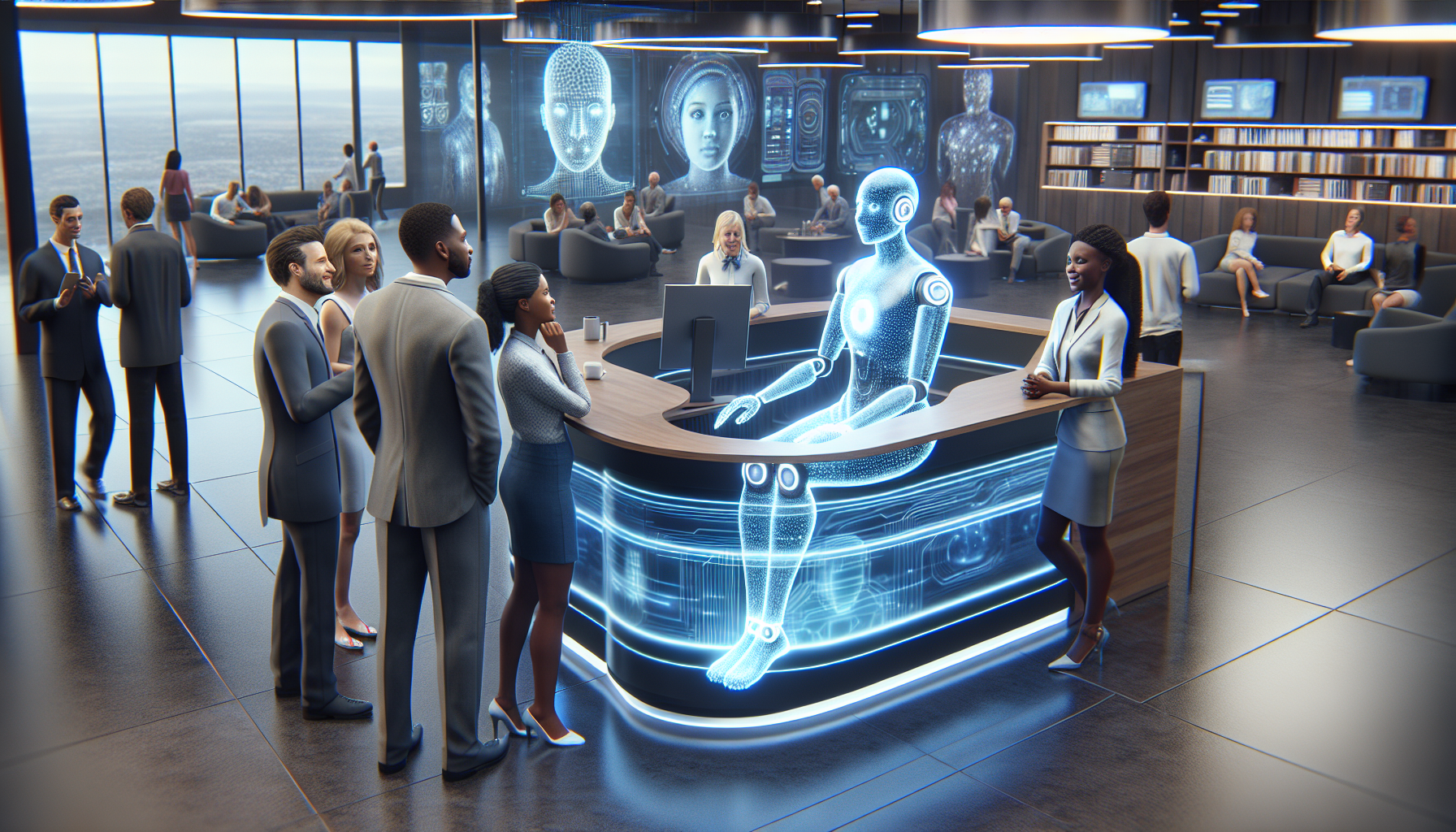
Emotion recognition technology, with its moves to the front lines of the technological revolution, has made its place in the realm of AI receptionist systems. This innovative technology interprets human emotions by analyzing expressions, tones, and body language. This opens up a plethora of possibilities, particularly in improving AI receptionist systems and transforming standard customer interactions into exceptional experiences.

This cutting-edge technology works primarily based on one principle: converting non-verbal signals into data. This data is then interpreted to understand the emotional state of the individual. Emotion recognition technology usually leverages deep learning and sophisticated computer vision algorithms to observe subtle shifts in facial features, speech patterns, and movements, thereby deducing human emotions.
The role of emotion recognition technology is highlighted within AI receptionist systems, where it is crucial to evaluate how customers emotionally respond to interactions. This becomes particularly significant in industries like hospitality, retail, and customer service, where an emotionally intelligent receptionist can make or break the customer's experience.
Through the integration of emotion recognition technology, AI receptionist systems evolve from just answering queries to creating empathetic interactions, forming more human-computer relations. This makes customers feel understood and valued, which in turn drives brand loyalty and improves customer satisfaction.
The dawn of emotion recognition technology has indeed upped the game in terms of AI receptionist capabilities. By recognizing and responding to human emotions, AI receptionists are now not just programmed software but entities capable of emotional intelligence, shaping a more empathetic and engaging customer experience.
The role of Emotional Intelligence in providing exceptional customer service simply cannot be understated. Research has shown that customers who experienced positive emotional connection with a company are likely to recommend it, use its services more, and spend more, thereby increasing a company's profitability. Therefore, recognizing emotions and responding appropriately to them forms an integral part of effective customer service.
Within the realm of AI technology, this behavioral attribute has been utilized to devise a genre of software known as Emotion Recognition AI. It's designed to understand and respond precisely to emotional cues during customer interactions, leading to more natural, empathetic human-computer interaction - a paramount need in the burgeoning sector of AI receptionists.
For instance, consider a scenario where a disgruntled customer interacts with an AI receptionist. A traditional AI may just respond mechanically to the stated grievances, even heightening the customer's frustration. In stark contrast, an AI with emotion recognition capability can detect the customer's annoyance and adjust its responses accordingly, thereby mimicking human receptionists and producing more fruitful outcomes.
A closer look at tech giants like Microsoft and Google highlights their burgeoning interest in this fascinating field. Google, for example, has been deeply invested in incorporating emotion-aware computing into its AI interfaces. By aligning technology's responses more closely with our emotional realities, it paves the path for a more seamless and empathetic interaction between humans and machines.
To sum up, the ability to recognize and respond appropriately to customer’s emotional states stands as a critical attribute for AI Receptionist technology. Not only does emotion recognition play a pivotal role in delivering superior customer service, it also impacts the overall acceptance of AI systems.
The rapidly evolving domain of artificial intelligence has given rise to numerous advanced technologies, one of which is the AI Receptionist. AI receptionists, or virtual customer service agents, have transformed the way businesses engage with customers. However, an essential aspect that is increasingly gaining attention in this field is Emotion Recognition.

Emotion recognition is a sophisticated technique that allows AI to identify and interpret human emotions. With this capability, AI receptionists can engage in more personalized and empathetic interactions. But incorporating emotion recognition into AI is not without its challenges.
Research indicates that teaching machines to understand emotions is a complex task due to the multilayered, subjective nature of human emotions. Moreover, the technical demands are significant. Complex algorithms, deep learning techniques, and large sets of accurate emotional data are required to train these systems effectively.
Despite the challenges, strides are being made. Current methodologies use a combination of facial recognition, voice tone analysis, and natural language processing to recognize and interpret emotional cues. Over time, these technologies refine their understanding of human emotions, enabling them to respond appropriately.
The impact of integrating emotion recognition into AI receptionists is substantial. Customers engage more positively with AI systems that understand and respond to their emotions. This leads to improved customer satisfaction and fosters a stronger relationship between businesses and their clients. As emotion recognition technology improves, the innate capacity of AI receptionists to offer empathetic customer service will only grow.
In conclusion, embedding emotion recognition into AI receptionist technology marks a significant advancement in the AI industry. Despite the complexity, the outcomes promise to revolutionize customer service interactions, providing more meaningful and engaging customer experiences.
Technology continues to push the bounds of what was once thought possible. We've seen this in action, most notably in the domain of Artificial Intelligence (AI). There is a growing trend to incorporate AI in numerous fields, and one such application is the role of receptionists. The development of AI Receptionist Technology has escalated at a rapid rate, more so with the incorporation of Emotion Recognition capabilities. We'll explore a few standout case studies to shed light on the utilization of these technologies and how they continue to shape our interactions.
XCorp, an AI tech giant, successfully implemented an AI receptionist called Mia. Mia has the capability to recognize and interpret human emotions in real-time through both voice and visual cues. Thanks to her highly responsive emotion recognition algorithms, Mia was able to provide personalized interaction to each visitor she encountered. Such a personal touch alleviated the former, rather impersonal, check-in process - boosting overall visitor experience and satisfaction.
An additional practical example is AIDA, the AI-powered airport assistant found at several international airports. In a field fraught with stress and rushed encounters, AIDA emerged as a calming presence—all thanks to emotion recognition capabilities. Visitors hailed AIDA's ability to quickly adjust its responses based on a user's emotion. Stress-induced visitors were given clarifying, soothing communications, whilst others, evidently bright and cheerful, were greeted with equal enthusiasm. As a result, AIDA improved overall airport experience by promptly recognizing and accurately responding to user’s emotions.
In summary, emotion recognition ability in AI Receptionist Technology paves the way for more intuitive and personalized interactions, signifying a pivot towards an era of empathetic machines. Mia and AIDA are real-world evidence of the powerful impact these AI solutions can have on enhancing customer service and satisfaction. Indeed, it's an exciting prospect to witness how emotion recognition continues to shape the evolution of AI.
Emotion recognition has already started transforming AI receptionist technology. It exhibits enormous potential to reshape completely how customer interfaces operate. Currently, artificial intelligence-based receptionists can recognize and react to basic emotional cues. This trend is expected to evolve and expand significantly in the future.

In the not too distant future, we may witness AI receptionist systems capable of comprehending complex emotional states which are usually challenging for even humans to understand fully. Advancements in machine learning algorithms and neural network systems will lay the foundation for these breakthrough developments.
Envision walking into a hotel. The AI receptionist is not just identifying your mood, but decoding your needs and desires based on the subtleties in your voice, your facial expressions, and body language. Rather than spewing scripted dialogues, it tailors its responses to your emotional state. As such, every customer interaction will become more personalized and empathetic, thus boosting user satisfaction.
There's also the promising prospect of using emotion recognition to provide accessibility features. People with speech or expression impairments could potentially communicate more effectively with AI-enabled systems that are skilled in understanding a wide range of emotional signals. The same goes for non-English speakers or those with heavy accents; innovative features could enhance the recognition of emotional nuances beyond mere language proficiency.
The future landscape of AI customer interactions will thus likely be more sensory-aware, reactive, inclusive, and ultimately more 'humane'. Despite being machines, AI receptionists could provide a human-like touch, becoming a crucial facet of effective customer relations. The importance of unlocking this potential cannot be overstated, paving the way for significant strides in how businesses deliver their services and ensuring that everyone, regardless of language, culture, or physical abilities, is catered to equally.
The integration of Emotion Recognition capabilities in AI receptionist technology brings forth an array of ethical considerations. As we continue to advance in harnessing the breadth of AI capabilities, it is critical to be cognizant of the moral and ethical responsibilities that come along with it. The application of emotion recognition AI, in essence, has the potential to infringe on individual privacy and autonomy, thus leading to ethical dilemmas.
One of the most notable ethical concerns arises from the potential privacy invasion facilitated by emotion recognition in AI technology. AI receptionist, capable of discerning emotions, by default necessitates continuous surveillance and data collection. Privacy commissioners have raised concerns over automated decision making and the potential abuse of personal emotional data. Even with consent, how granular is the information being collected and could it unintentionally cross the boundary of what is considered personal?
Another significant ethical quandary stems from the moral responsibility of developers and corporations using this technology. Is it ethical for artificial intelligence to manipulate human emotion, even subtly, in a commercial environment? Instances of AI manipulating user behavior have already been flagged as unethical by large scale scandals, highlighting the deep-seated ethical implications.
Moreover, the increasing prevalence of 'Emotional AI' sparks concerns over the potential for emotional manipulation. While these technologies can enhance customer experience, there is a fine line between helpful personalization and manipulative intrusion. An AI receptionist programmed to capitalize on human emotions could lead to exploit vulnerabilities, raising significant ethical alarms.
Overall, the ethical considerations of incorporating emotion recognition in AI receptionist technology demand deep introspection and continuous monitoring. As developers continue with these advancements, equal emphasis should be placed on crafting ethical guidelines that protect user privacy and prohibit emotional manipulation.
Start your free trial for My AI Front Desk today, it takes minutes to setup!








